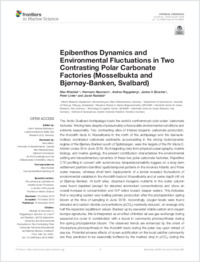Epibenthos dynamics and environmental fluctuations in two contrasting polar carbonate factories (Mosselbukta and Bjørnøy-banken, svalbard)
- Wisshak, Max Marine Research Department, Senckenberg am Meer, Wilhelmshaven, Germany
- Neumann, Hermann Marine Research Department, Senckenberg am Meer, Wilhelmshaven, Germany
- Rüggeberg, Andres Department of Geosciences, University of Fribourg, Switzerland
- Büscher, Janina V. Research Division 2: Marine Biogeochemistry, GEOMAR – Helmholtz Centre for Ocean Research, Kiel, Germany
- Linke, Peter Technology & Logistics Centre, GEOMAR – Helmholtz Centre for Ocean Research, Kiel, Germany
- Raddatz, Jacek Institute of Geosciences, Goethe University Frankfurt, Germany
- 18.11.2019
Published in:
- Frontiers in Marine Science. - 2019, vol. 6, p. 667
English
The Arctic Svalbard Archipelago hosts the world’s northernmost cold-water ‘carbonate factories’ thriving here despite of presumably unfavourable environmental conditions and extreme seasonality. Two contrasting sites of intense biogenic carbonate production, the rhodolith beds in Mosselbukta in the north of the archipelago and the barnacle-mollusc dominated carbonate sediments accumulating in the strong hydrodynamic regime of the Bjørnøy-Banken south of Spitsbergen, were the targets of the RV Maria S. Merian cruise 55 in June 2016. By integrating data from physical oceanography, marine biology, and marine geology, the present contribution characterises the environmental setting and biosedimentary dynamics of these two polar carbonate factories. Repetitive CTD profiling in concert with autonomous temperature/salinity loggers on a long-term settlement platform identified spatiotemporal patterns in the involved Atlantic and Polar water masses, whereas short-term deployments of a lander revealed fluctuations of environmental variables in the rhodolith beds in Mosselbukta and at same depth (46 m) at Bjørnøy-Banken. At both sites, dissolved inorganic nutrients in the water column were found depleted (except for elevated ammonium concentrations) and show an overall increase in concentration and N:P ratios toward deeper waters. This indicates that a recycling system was fuelling primary production after the phytoplankton spring bloom at the time of sampling in June 2016. Accordingly, oxygen levels were found elevated and carbon dioxide concentrations (pCO2) markedly reduced, on average only half the expected equilibrium values. Backed up by seawater stable carbon and oxygen isotope signatures, this is interpreted as an effect of limited air-sea gas exchange during seasonal ice cover in combination with a boost in community photosynthesis during the spring phytoplankton bloom. The observed trends are enhanced by the onset of rhodophyte photosynthesis in the rhodolith beds during the polar day upon retreat of sea-ice. Potential adverse effects of ocean acidification on the local calcifier community are thus predicted to be seasonally buffered by the marked drop in pCO2 during the phase of sea-ice cover and spring phyto-plankton bloom, but this effect will diminish should the seasonal sea-ice formation continue to decline. Among the 25 macrobenthos taxa identified from images captured by the lander’s camera system, all but three species were calcifiers contributing to the carbonate production. Biodiversity was found to be much higher in Mosselbukta (21 taxa) compared to Bjørnøy-Banken (8 taxa), which is considered as a result of enhanced habitat diversity provided in the rhodolith beds by the bioengineering crustose alga Lithothamnion glaciale. Filter- feeding activity of selected key species did reveal group-specific but no common activity patterns. Biotic disturbance of the filtering activity was common, in contrast to abiotic factors, with hermit crabs representing the primary trigger. Motion tracking of rhodoliths revealed a high frequency of dislocation, triggered not by abiotic factors but by the activity of benthic invertebrates, in particular echinoids ploughing below or moving over the rhodoliths. The echinoid Strongylocentrotus sp. is the most abundant component of the associated fauna, thereby considerably contributing both to carbonate production and to grazing bioerosion. Together, these results portray a high degree of seasonal as well as short-term dynamics in environmental conditions that despite many similarities support distinctly different communities and biodiversity patterns in the calcifying macrobenthos at the two studied polar carbonate factories.
- Faculty
- Faculté des sciences et de médecine
- Department
- Département de Géosciences
- Language
-
- English
- Classification
- Biological sciences
- License
-
License undefined
- Identifiers
-
- RERO DOC 327715
- DOI 10.3389/fmars.2019.00667
- Persistent URL
- https://folia.unifr.ch/unifr/documents/308440
Statistics
Document views: 116
File downloads:
- pdf: 209
